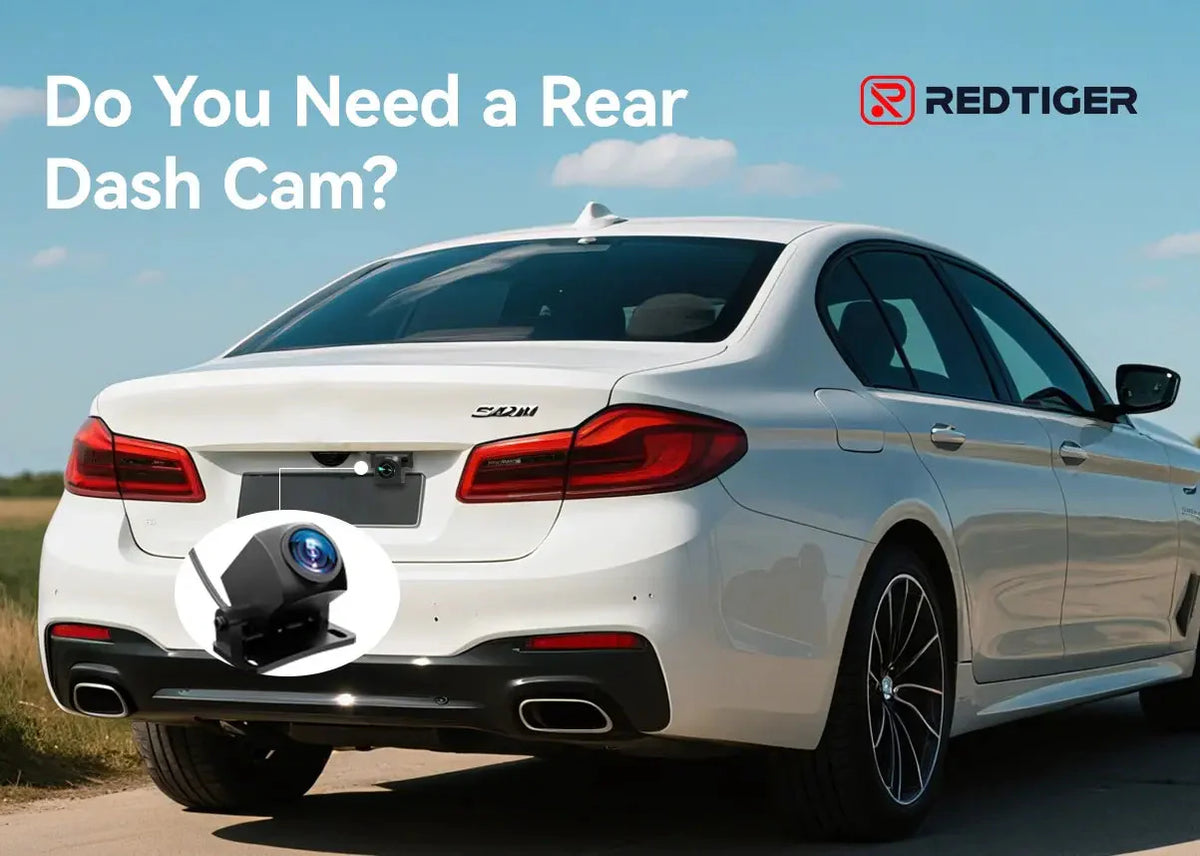

You already know a front dash cam helps keep your drives safe by recording what goes on in front of your car. But have you asked yourself, should you get a rear dash cam too? Adding a rear dash cam can give you complete coverage and set your mind at ease. It captures tailgating, hit-and-run accidents and parking lot troubles. In this article, you will learn how a rear camera works, why it is useful and how a Redtiger dual dash cam can give you security and maybe even save you money. Let’s go through it all together.
What Is a Rear Dash Cam and How Does It Work?
A rear dash cam is a second camera you place on the back window or the rear part of your car. Its job is simple: record everything happening behind you. Many times, it works with your front dash cam, so you get videos from both the front and back. This full view makes driving safer and means you have more records just in case something happens.
Footage a Rear Dash Cam Can Capture
A rear dash cam can record things like someone bumping into your car from behind, parking lot dings or incidents where a person or another car is behind you. It even catches cars rolling back toward you at a stop. Good video clips from a rear dash cam can prove what really happened when you need to talk to insurance or the police.
Front vs Dual Dash Cam: What’s the Difference?
Front Dash Cam
Your front dash cam films what you see through your windshield. It is perfect for recording accidents, getting pulled over or when someone crashes into you from the front. It can’t show what is going on behind your car, though, so you could miss out on important footage.
Dual Dash Cam
A dual dash cam features both a front camera and a rear camera, and records both the road ahead and what’s going on behind you. That means you have a record of everything. If something strange happens on either side, you will have footage showing exactly what took place. It offers peace of mind and proof, no matter which way things happen.
Key Differences
- A front dash cam films only what’s in front of your car. It’s good for proof if you need it, but it misses anything happening behind you.
- A rear dash cam records what happens behind your car whether you are driving or parked. It helps keep you safe and gives you more ways to prove what happened.
- A dual dash cam records front and back at the same time. You get a full picture and peace of mind knowing you are covered everywhere.
Do You Need a Rear Dash Cam?
If you want to be safe, the answer is yes, you should get a rear dash cam. It offers coverage that front cams don’t and that can save you a lot of worry (and money) later.
Complete Incident Coverage
With a rear dash cam, everything that happens behind your car is recorded. If you’re ever in an accident or someone claims you did something wrong, you will have the video to show what really happened. This helps when talking to police or your insurance.
Tailgate Protection
Rear dash cams are great for catching aggressive drivers. Tailgaters sometimes cause accidents, then try to blame you. Your dash cam gives clear proof of their behavior if something goes wrong which is helpful for insurance and police.
Parking Security
Even parked cars get hit sometimes. A rear camera keeps recording, so if someone damages your car in a parking lot you can show your insurance what happened. This makes getting help easier and can save you money on repairs.
Peace of Mind on the Road
With cameras on both front and back, you’ll worry less. Knowing everything is being recorded lets you concentrate on driving and staying safe, not on what evidence you’ll need if there is a problem.
Makes Insurance Easier
Dash cam clips from the back and front make claims faster. They give you proof for tough situations, so you’re less likely to be blamed for something that wasn’t your fault. This can help finish claims quickly and fairly.
Easy Cloud Access
Some new dash cams, like Redtiger’s wireless models, save your videos to the cloud. That means you can easily view, download or share any clip—no more searching for small memory cards or needing a computer. Everything’s at your fingertips when you need it.
Common Scenarios Where a Rear Dash Cam Helps
Urban Driving in Heavy Stops
In busy traffic, stops can be sudden. If someone bumps into your rear bumper, you want video proof. Your rear dash cam will show the details, including who was at fault. If someone also tries to claim it was your mistake, you can prove what really happened.
Highway Incidents and Tailgating
Drivers on highways sometimes follow too closely, causing crashes. A rear dash cam records these drivers, any sudden stops and what happened if there’s impact. That way, you won’t be blamed for something that’s not your fault.
Busy Parking Lots
Finding a space in a crowded lot isn’t easy and accidents happen. Your rear camera records parking bumps or hits, so you can show what happened if your car gets scratched or dented—even when you’re not there.
Rideshare or Taxi Drivers
If you drive for Uber, Lyft or a taxi company, a rear dash cam gives you an extra level of safety. You can record any issues with passengers or other drivers. Having a video record helps you stay comfortable and protected through each ride.
Poor Visibility in Bad Weather
When weather gets bad, like during rain or at night, it’s hard to know what’s behind you. Your rear dash cam keeps filming with a clear view, often seeing better than mirrors can. That way, you always know what’s going on around you.
How Do You Install a Rear Dash Cam?
Putting your dash cam in place isn’t hard. Here’s how to install your rear camera:
Mounting Your Camera
Try to place your rear dash cam high up on the back window and in the center. You want a good view of every lane behind you. Clean the glass to help the sticky mount hold strong.
Connecting With Your Front Camera
With a Redtiger system, you usually just plug the rear cam into the front unit using a cable. Hide the wire by tucking it along the edge of your car’s ceiling or door frame.
Getting Power and Loop Mode
Usually, you plug the power cable into the front cam or car’s fuse box. Make sure to turn on loop mode, so old files are replaced with new ones. That way, your camera keeps recording and you don’t run out of memory.
Aiming for the Best Shot
After you turn it on, check the camera’s angle. You want the road straight and the view centered, so you see all traffic and can catch any impact.
Testing at All Times
Try your dash cam during sunny days and at night. Tweak the settings if night videos look dark or blurry, so you can always see what’s recorded.
Choosing the Right Front and Rear Dash Cam Combo
A dual dash cam setup offers front and rear protection, but not all models are created equal. To get the most out of your investment, it’s important to know which features truly matter. Below are the key features to look for in a high-quality front and rear dash cam; each one plays a role in how well your camera captures footage, protects your vehicle, and fits into your daily driving routine.
Wide-Angle Lenses
Choose a dash cam setup with a wide-angle lens of at least 140 degrees. This helps you see more of the road and any car approaching from the sides.
Loop Recording
With loop recording, the camera saves clips in small parts. When the memory is full, it deletes the oldest parts to save new ones. You’ll never need to worry about clearing space—the dash cam handles it for you.
Parking Mode
Parking mode means the dash cam knows when your car is stopped. It can turn on, record if anything happens, but also save battery since it isn’t on all the time. This way, your car is watched over even when you’re not around.
Night Vision
You want your dash cam to see well even when it’s dark. Go for models with good sensors or infrared so you get a sharp picture. That way, you’ll have proof, even in the middle of the night.
Wireless Access & App Support
Many new dash cams let you connect with your phone. You can watch long or short videos on the app or share a video with your insurance instantly—no more dealing with tiny memory cards.
If you want safety front and back, go for a dual channel dash cam like the Redtiger model. It lets you film what’s going on in front and behind, for complete protection every drive.
Feature |
Redtiger Front Only Dash Cam
|
Redtiger Dual Front & Rear Dash Cam |
Rear Recording |
No |
Yes |
Full Coverage |
Only front view |
Front and rear view |
Installation Effort |
Easy |
Moderate |
Parking Mode |
Yes |
Enhanced dual mode |
Conclusion
Still thinking, should you get a rear dash cam? The answer is yes. A rear dash cam means more proof, better safety and full records whether you’re driving or parked. A dual dash cam, like Redtiger’s, gives you smart features, reliable evidence and peace of mind. Don’t leave your safety up to chance—get a dual dash cam and enjoy the road with confidence.
FAQs
Is only front dash cam enough?
A dash cam in the front is good, but you won’t see what happens behind you. For parking or rear crashes, a dual cam gives you total coverage and safety.
Is it worth having a rear camera?
Yes. It protects you from tailgaters, parking bumps and more. You get more proof for insurance or the police which saves time and hassle.
How rear dash cams help with insurance claims?
It records what happened in rear-end crashes or if someone just drives off. You can show the clip to your insurance and get help faster, with less arguing.
Is it hard to install a rear dash cam?
Most are pretty easy. Most kits let you just plug things in and run wires along your car’s trim. Some patience helps, but it isn’t hard.
Do you really need a rear dash cam if you have a backup camera?
A backup camera is helpful for parking but it doesn’t record anything. A rear dash cam works all the time, while you drive or while parked and keeps important videos for proof whenever you need it.

